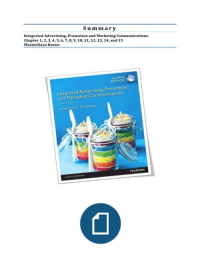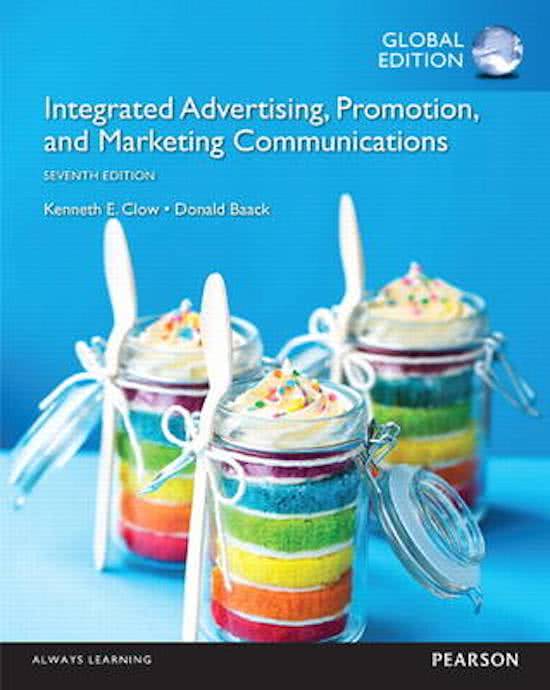Summary
Integrated Advertising, Promotion and Marketing Communications.
Chapter 1, 2, 3, 4, 5, 6, 7, 8, 9, 10, 11, 12, 13, 14, and 15
Maximiliaan Koene
,Chapters
Chapter 1: Integrated Marketing Communications............................................................. 3
Chapter 2: Brand Management .......................................................................................... 6
Chapter 3: Buyer Behaviours.............................................................................................11
Chapter 4: The IMC Planning Process ................................................................................16
Chapter 5: Advertising Campaign Management ................................................................22
Chapter 6: Advertising Design ...........................................................................................27
Chapter 7: Traditional Media Channels .............................................................................32
Chapter 8: Digital Marketing .............................................................................................39
Chapter 9: Social Media ....................................................................................................44
Chapter 10: Alternative Marketing....................................................................................47
Chapter 11: Database and Direct Response Marketing and Personal Selling ......................50
Chapter 12: Sales promotions ...........................................................................................57
Chapter 13: Public relations and sponsorship programs ....................................................63
Chapter 14: Regulations and Ethical Concerns ...................................................................67
Chapter 15: Evaluating an Integrated Marketing Program .................................................72
2
,Chapter 1: Integrated Marketing Communications
1.1 How does communication take place?
Communications: Transmitting, receiving, and processing information.
Communication process:
This communications model provides the
foundation for an advertising and
marketing program.
Senders: The person(s) attempting to deliver a message or idea.
Encoding: The verbal (words/sounds) and nonverbal (gestures/facial
expressions/posture) cues that the sender utilizes in dispatching a
message.
Transmission devices: All of the items that carry a message from the sender to the
receiver.
Decoding: What occurs when the receiver employs any of his/her senses
(hearing/seeing/feeling) in a attempt to capture a message.
Receivers: The intended audience for a message.
Feedback: the information the sender obtains from the receiver regarding the
receiver’s perception or interpretation of a message.
Noise: Anything that distorts/interrupts a message.
Clutter: What exists when consumers are exposed to hundreds of marketing
messages per day, and most are tuned out.
1.2 What is an integrated marketing communications program?
Integrated marketing communications: The coordination and integration of all
(IMC) marketing communication tools,
avenues, and sources in a company into
a seamless program designed to
maximize the impact on customers and
other stakeholders.
Marketing mix: The elements of a marketing including products, prices, places (the
distribution system), and promotions.
-A complete IMC plan combines every element.
3
,Components of Promotion: (9)
Advertising
Public Digital
Relations Marketing
Sales
Promotions Social Media
Promotions
Personal Alternative
selling Marketing
Direct Database
Response Marketing
Steps of a Marketing Plan:
• Current situational analysis • Marketing strategies
• SWOT analysis • Marketing tactics
• Marketing objectives • Implementation
• Target market • Evaluation of performance
1.3 What trends are affecting marketing communications? (7)
1 Emphasis on accountability and measurable results
2 Explosion of the digital arena
3 Integration of media platforms
4 Shift in channel power
Retailers; -Control shelf space
-Have purchase data
-Determine products and brands on shelves
Consumers; -Internet shifts power to consumers
-Multiple methods of making purchases
5 Increase in global competition
-Not competing only with your neighbours; worldwide.
6 Increase in brand parity
Brand parity: What occurs when there is the perception that most goods
and services are essentially the same.
o Brands viewed as being Equivalent
o Price More Important
o Decline in brand loyalty
4
,7 Emphasis on customer engagement
Contact point:Any place where customers interact with or acquire
additional information about a firm.
o Contact points are important
o Digital media; two-way communication
o Strive to develop emotional commitment
o Build commitment and loyalty
1.4 What are the components of an integrated marketing communications
program?
1.5 What does the term GMIC mean?
GMIC: Globally integrated marketing communications programs
-Trends among advertising agencies in the international arena.
-Goal remains the same: to coordinate marketing efforts
-‘Think globally, act locally’
Marketers employ two different strategies for global companies:
1. Standardization: A program in which a firm features uniform products
and market offerings across countries with the goal of
generating economies of scale in production while
using the same promotional theme.
2. Adaption: What takes place when products and marketing messages
are designed for and adapted to individual countries.
5
,Chapter 2: Brand Management
2.1 How does a brand’s image affect consumers, other businesses, and the
company itself?
Corporate/brand image: Summarizes what the company stands for as well as how it
is known in the marketplace.
Created due to; -Quality of goods
-Willingness of a firm to stand behind its goods
-Perception of how firms deal with customers
Components of Corporate/Brand image: (2)
Tangible elements Intangible elements
• Goods or services sold • Corporate personnel;
• Retail outlets -Ideals
• Advertising -Beliefs
• Marketing Communications -Conduct
• Name and Logo • Environment policies
• Package and labels • Corporate culture
• Employees • Country location
• Media reports
Brand Image: Benefits to Consumers:
• Provides confidence regarding purchase decisions
• Gives assurance about the purchase when the buyer has little or no previous experience
• Reduces search time in the purchase decision
• Provides psychological reinforcement and social acceptance of the purchase
Brand Image: Benefits to Companies:
• Extension of positive feelings to new products
• Ability to charge a higher price or fee
• Consumer loyalty leading to more frequent purchases
• Positive word-of-mouth endorsements
• Higher level of channel power
• Ability to attract quality employees
• More favourable ratings by financial observers and analysts
Brand alliance: Two companies use brand strength to develop and co-market a new
product featuring both names.
6
,2.2 What elements are involved in identifying, creating, rejuvenating, or changing a
brand’s image?
Keys to Successful Image Rejuvenation:
• Help former customers rediscover the brand
• Offer timeless consumer value
• Stay true to original, but contemporize
• Build a community
Image rejuvenation:
• Sells new products • Key- remain consistent with old and
• Attracts new customers new
• Retains current customers • Takes time and effort
2.3 What are the different types of brand names?
Brand name: Provides the overall banner for operations.
Categories of Brand Names: (4)
1. Overt names;
-Reveal what a company does
2. Implied names;
-Contain recognizable words/word parts that convey what a company does.
3. Conceptual names;
-Capture the essence of what a company offers
4. Iconoclastic names;
-Represent something unique, different, and memorable.
2.4 What are the characteristics of effective logos?
Brand logo: The symbol used to identify a brand, helping to convey the overall brand image.
Four tests of quality logos and brand names:
• Recognizable
• Familiar
• Elicits a consensual meaning among those in the firm’s target market
• Evokes positive feelings
Stimulus codability: Feelings attached to items that evoke consensually held meanings within
a culture or subculture.
Tips on creating or changing logos:
• The logo is a reflection of the brand
• Creating logos requires knowledge and expertise
• Use professional designers
• Make the logo simple
• Make the logo media transferrable
7
, 2.5 What different kinds of brand can firms offer?
1. Family brands: A group of related products sold under one name.
2. Brand extension: The use of an established brand name on products/services not related to
the core brand.
3. Flanker brand: The development of a new brand sold in the same category as another
product.
4. Co-Branding: The offering of two or more brands in a single marketing offer.
-Also known as ‘alliance branding’
-Three types:
o Ingredient branding: The placement of one brand within another brand.
o Cooperative branding: The joint venture of two or more brands into a new
product/service.
o Complementary branding: The marketing of two brands together for co-consumption.
5. Private brands: Proprietary brands marketed by an organization and sold within the
organization’s outlets.
2.6 How are brands developed, built, and sustained in order to build brand equity
and fend off perceptions of brand equity?
Salient: A situation in which consumers are aware of the brand, have it in their
consideration sets (things they consider when making purchases), regard the
product and brand as a good value, buy it or use it on a regular basis, and
recommend it to others.
Building Powerful Brands:
• Invest in the brand • Offer value
• Create awareness • Utilize social media
• Offer authenticity uniqueness • Utilize mobile
• Build trust • Act responsibly
• Deliver an experience
Trust: A customer’s belief that few tangible distinctions exist between competing
brands in mature markets.
Brand Loyalty
• Ultimate objective
• Only brand that customers purchase
• Drivers are; emotion and value
• Consumer experience
Brand parity: View of consumers that few tangible distinctions exist between competing
brands in mature markets.
Brand equity: The perception that a good or service with a given brand name is different,
better, and can be trusted.
8





